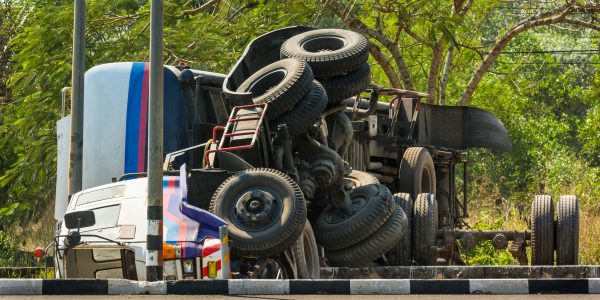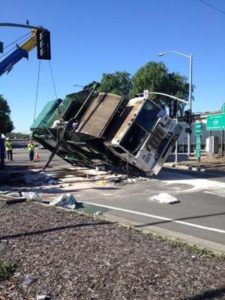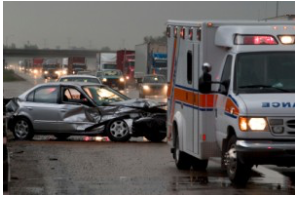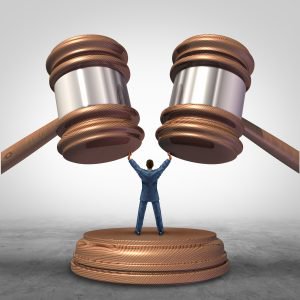 Tractor-trailers are huge machines. Some can weigh as much as 80,000 pounds and, when traveling at highway speeds they can create carnage in a collision, leading to serious injuries and death.
Tractor-trailers are huge machines. Some can weigh as much as 80,000 pounds and, when traveling at highway speeds they can create carnage in a collision, leading to serious injuries and death.
Unfortunately, few people injured in tractor-trailer collisions hire competent legal counsel immediately after the collision. Most trucking companies and their insurers have accident investigation teams that are dispatched immediately after a crash to the scene. These accident investigation teams immediately begin to collect and preserve evidence, identify and take statements from witnesses, and reconstruct the accident. Their entire focus, while ostensibly to determine the cause of the accident, is to protect the trucking company and the insurer.

Our experience has been, that despite the immediate collection of evidence, and accident scene investigation by the insurance company and trucking company investigation teams, many instances of undiscovered, undocumented, and destroyed evidence can be found by competent counsel working for injured parties.
Trucking cases are not run-of-the-mill automobile cases. They require attorneys who are skilled and knowledgeable in the mechanics and technology of large trucks, have a working understanding of the trucking industry, and are versed in the federal and state regulations governing large trucks.
Trucking technology, if understood and applied properly, can not only assist the plaintiff’s counsel in determining the actual cause of a collision but in many cases can prevent these deadly collisions.
According to the National Highway Traffic Safety Administration, 93% of all accidents involve driver error, with the majority related to driver inattention. NHTSA research also shows that one extra second of warning could prevent up to 99% of rear-end collisions.
Advanced accident avoidance systems are available and, and though not presently required by law or regulation, failure to implement the technology could be admissible in the right case as evidence of negligence on the part of the trucking company.
There are several types of warning systems which can provide data as to what warnings were given and what conditions were detected. Unfortunately, these systems can be ignored or rendered inoperable.
In many of our cases, the tractors are equipped with onboard computers, which can tell the speed of the tractor-trailer at the time of the collision, which have been rendered inoperable or never activated. If operable at the time of a collision these computers can be downloaded to give critical data about the cause of the collision. Especially important is the speed readings of the vehicle which can be recorded just prior o a hard braking incident or collision.
Forward, side, and rear object detection systems monitor the roadway and potential hazards around the tractor-trailer. These systems sweep the roadway in front, on the side, and to the rear of the tractor-trailer. By monitoring these conditions, a truck driver can establish safe intervals ahead of the vehicle. With the many distractions faced by drivers, a warning of an approaching object can save many lives. Also, these systems work in inclement weather, giving the driver a greater ability to see through fog, rain, snow or sleet.
Rear object detection systems monitor a specific area behind a tractor-trailer. They detect objects and provide warnings to drivers when they approach an object behind a vehicle while in reverse. These systems assist the driver in avoiding collisions during backing or parking maneuvers. Loadings and crush injuries can be avoided by monitoring these devices. Most are functional for 20-30 feet behind a tractor-trailer. 
Lane departure warning systems are in-vehicle electronic systems that monitor the position of the vehicle within a roadway lane and warn a driver if the vehicle deviates or is about to deviate outside the lane. With the increasing dangers presented by fatigued driving, these lane departure warning systems can prevent many deaths on the highways of the United States.
The currently available lane departure warning systems are forward-looking, vision-based systems that use algorithms to interpret video images, to estimate vehicle position, and roadway alignment. These systems warn the driver of a lane departure when the vehicle is traveling above a certain speed and the vehicle’s turn signal is not in use. In addition, these systems notify the driver when lane markings are inadequate for the detection or if the system malfunctions. The systems do not take any automatic action to avoid a lane departure or to control the vehicle. The driver remains responsible for the safe operation of the vehicle. When the vehicle is traveling in close proximity to the center of the lane, it is with the system’s “no warning zone.” In this zone, the system does not issue any position warnings.
Tracking communications systems permit GPS tracking, reconstruction of routes, times, hours of service issues, and they also provide data provided to drivers on the weather and other road conditions. Matching a driver’s logbooks to satellite positioning data can test the accuracy of the records and perhaps prove that the logs were falsely maintained. This data can include texting data between dispatch and the drivers and can provide documentation of speeding, hard braking, or other safety-related issues. These tracking systems also provide safety managers the ability to remotely monitor drivers in the field, and determine their safety habits. Of course, this information is crucial in any tractor-trailer lawsuit.
 A lot of individuals ask their animal attack attorney why their insurance provider should pay for their hospital bills and not the insurance company of the individual who was the reason behind the incident. This has often been a cause of misconception and misunderstanding between people and that is why it is worth discussing on this section.
A lot of individuals ask their animal attack attorney why their insurance provider should pay for their hospital bills and not the insurance company of the individual who was the reason behind the incident. This has often been a cause of misconception and misunderstanding between people and that is why it is worth discussing on this section.


 Tractor-trailers are huge machines. Some can weigh as much as 80,000 pounds and, when traveling at highway speeds they can create carnage in a collision, leading to serious injuries and death.
Tractor-trailers are huge machines. Some can weigh as much as 80,000 pounds and, when traveling at highway speeds they can create carnage in a collision, leading to serious injuries and death.
